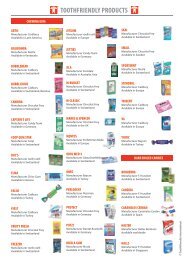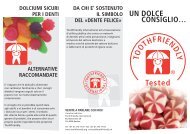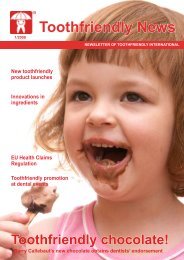TRENDS - Toothfriendly International
TRENDS - Toothfriendly International
TRENDS - Toothfriendly International
You also want an ePaper? Increase the reach of your titles
YUMPU automatically turns print PDFs into web optimized ePapers that Google loves.
Singapore leads sugar-free candy consumption in South East Asia<br />
Singaporeans have a sweet tooth for toothfriendly<br />
confectionery, suggests the latest<br />
market data from Euromonitor: over 37% of<br />
all candies and 67% of mints are now sold<br />
as “sugar-free”. When it comes to healthy<br />
snacking, Singaporeans have an edge over<br />
neighbouring Malaysia, Thailand, Philippines<br />
and Vietnam.<br />
According to Antje Schröder, the Marketing<br />
Manager of BENEO-Palatinit in South East<br />
Asia, the growth of the Singaporean sugarfree<br />
market is driven especially by concerns<br />
about dental health and obesity.<br />
“Singapore is often seen as South East<br />
Asia’s health-conscious hub”, Schröder says.<br />
“With high standards of oral health and the<br />
second-highest per capita income in Asia,<br />
Singapore’s demand for sugar-free products<br />
is strong.”<br />
Cargill greets<br />
stevia approval<br />
The recent stevia approval in France<br />
is bound to speed up product<br />
development with Rebaudioside A,<br />
the best-tasting component of the<br />
stevia leaf.<br />
“We welcome the French approval<br />
for the use of rebiana. This approval<br />
comes after years of research and<br />
significant investment by Cargill<br />
to establish the safe use of steviol<br />
glycosides in food and beverages,”<br />
said Zanna McFerson, assistant<br />
vice president, Cargill Health and<br />
Nutrition.<br />
Truvia rebiana, which is 200 times<br />
sweeter than sugar yet toothfriendly,<br />
opens up a whole new category<br />
of zero-calorie natural sweeteners.<br />
Cargill’s Truvia rebiana is currently<br />
available in the USA both in a tabletop<br />
sweetener and as an ingredient<br />
for food and beverage products.<br />
With the approval of rebaudioside<br />
A, Truvia sweetener will soon be<br />
available to French consumers.<br />
Switzerland was the first European<br />
country to launch stevia-sweetened<br />
products in 2009.<br />
In Malaysia, sugar-free confectionery currently<br />
occupies 10% of the market, whereas<br />
Thailand and Philippines boast 8% and 6%<br />
market shares for sugar-free sweets, respectively.<br />
In Vietnam, the sugar-free candy<br />
market is still practically non-existing.<br />
Despite the faltering economy, confectioners<br />
and market analysts say they expect the<br />
market for sugar-free products to continue<br />
throughout South East Asia.<br />
“<strong>Toothfriendly</strong> sweets such as mints and<br />
lozenges are seen as a healthy and affordable<br />
indulgence, claims Schröder. “In recent<br />
years sugar-free products have been significantly<br />
improved in terms of taste, colour,<br />
texture and the choice of products available.<br />
Consumers who are looking for healthier<br />
alternatives do not have to compromise on<br />
taste anymore.”<br />
Isomaltulose in new beverage applications<br />
New product applications with isomaltulose<br />
widen the horizon for food manufacturers.<br />
Besides chocolate, isomaltulose can now<br />
also be used in toothfriendly beverages<br />
such as ice teas, flavoured waters or cocoa<br />
drinks.<br />
Isomaltulose is the only fully digestible low<br />
GI carbohydrate that provides prolonged<br />
energy release in the form of glucose while<br />
being completely toothfriendly, as approved<br />
by the FDA (Food and Drug Administration).<br />
A beverage can be labelled as “toothfriendly”<br />
only if it demonstrably causes neither<br />
caries nor dental erosion. Consequently,<br />
the product concept has to be built on a<br />
formulation which does not contain any fermentable<br />
sugars nor unacceptable amounts<br />
of citric or phosphoric acids.<br />
As a bulk sweetener isomaltulose provides<br />
excellent mouth feel which usually lacks<br />
from beverages sweetened solely with<br />
intense sweeteners. However, as isomaltulose<br />
has a sweetness level only half that of<br />
sucrose, some intense sweeteners may be<br />
needed to round up the flavour.<br />
In toothfriendly beverages, the limitation<br />
on acid use is more difficult to overcome,<br />
as relatively low levels of acid can attack<br />
the dental enamel. For the formulation of a<br />
toothfriendly beverage, acids with no or low<br />
buffering capacity are required. Adding cal-<br />
Sugar-free candy market (%)<br />
in South East Asia 2009<br />
Singapore<br />
all sugar-free candies 37%<br />
growth since 2004 +6%<br />
Malaysia<br />
all sugar-free candies 12%<br />
growth since 2004 +16%<br />
Indonesia<br />
all sugar-free candies 10%<br />
growth since 2004 +15%<br />
Thailand<br />
all sugar-free candies 8.5%<br />
growth since 2004 +56%<br />
Vietnam<br />
all sugar-free candies 0.7%<br />
growth since 2004 +230%<br />
Sugar-free - Retail Value RSP - % breakdown<br />
©2009 Euromonitor <strong>International</strong><br />
cium will compensate only for some but<br />
not all the negative dental effects of the<br />
acids. Therefore, adding calcium salts and<br />
thickeners is not a solution. The most effective<br />
measure is to lower the acidity of the<br />
product. This, however, may have implications<br />
for the microbiological stability of the<br />
product, except if aseptic packaging can be<br />
guaranteed.<br />
With the launch of Good for Me drink, Swiss<br />
retailer Migros added a new member to its<br />
successful beverage family, and at the same<br />
time launched the first soft drink to make an<br />
explicit connection to healthy teeth.<br />
<strong>Toothfriendly</strong> News 1/2010 9









